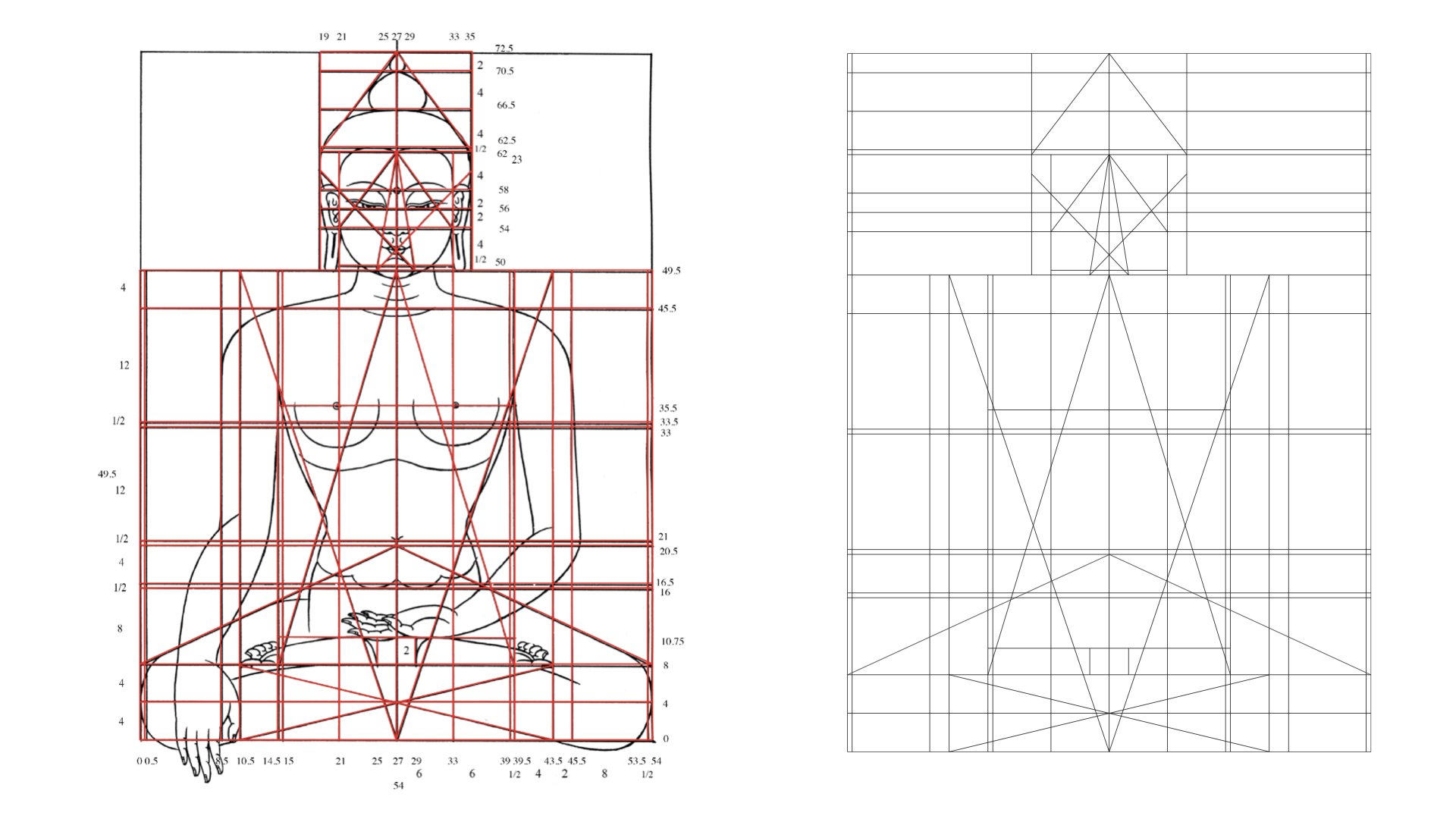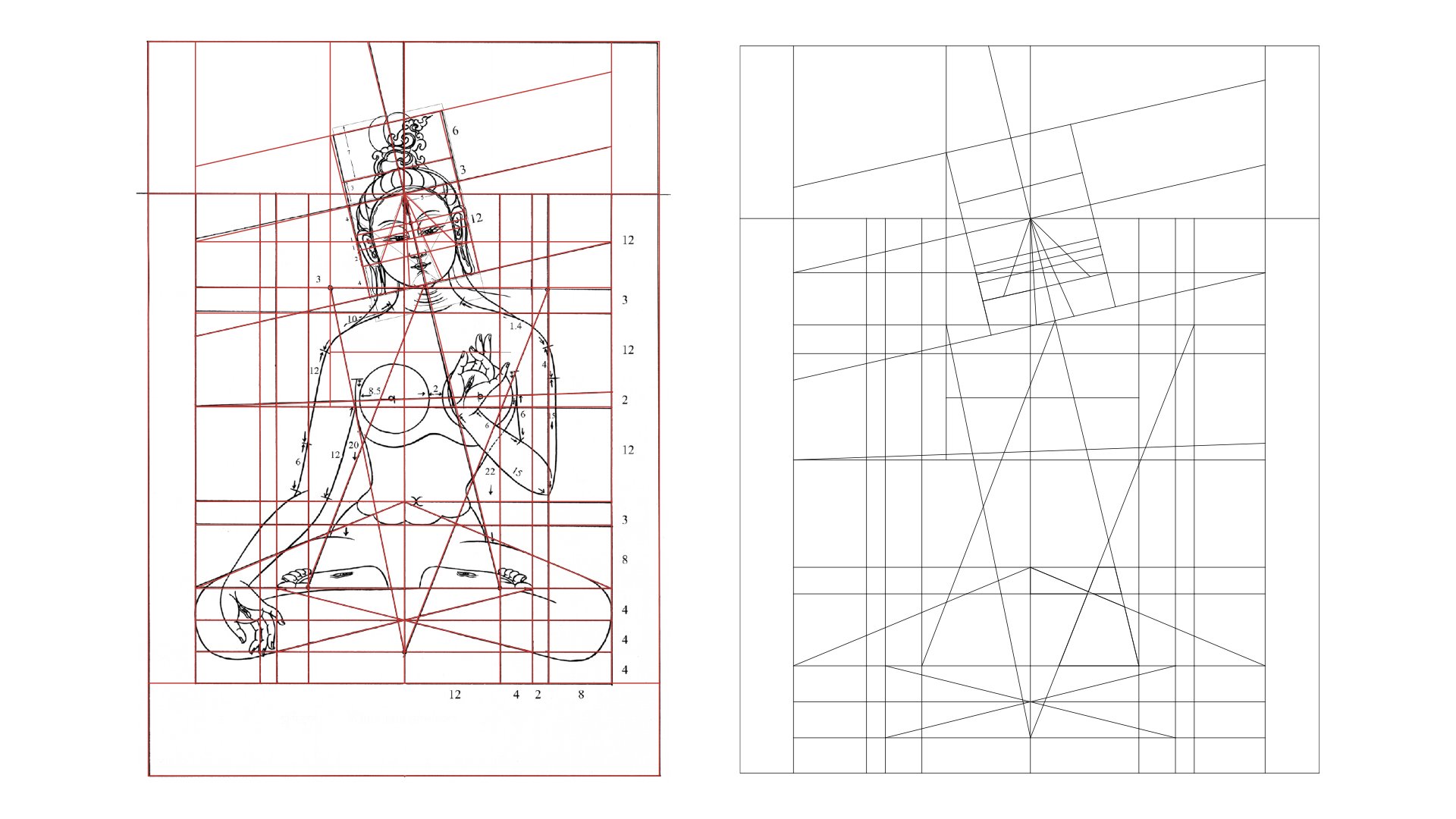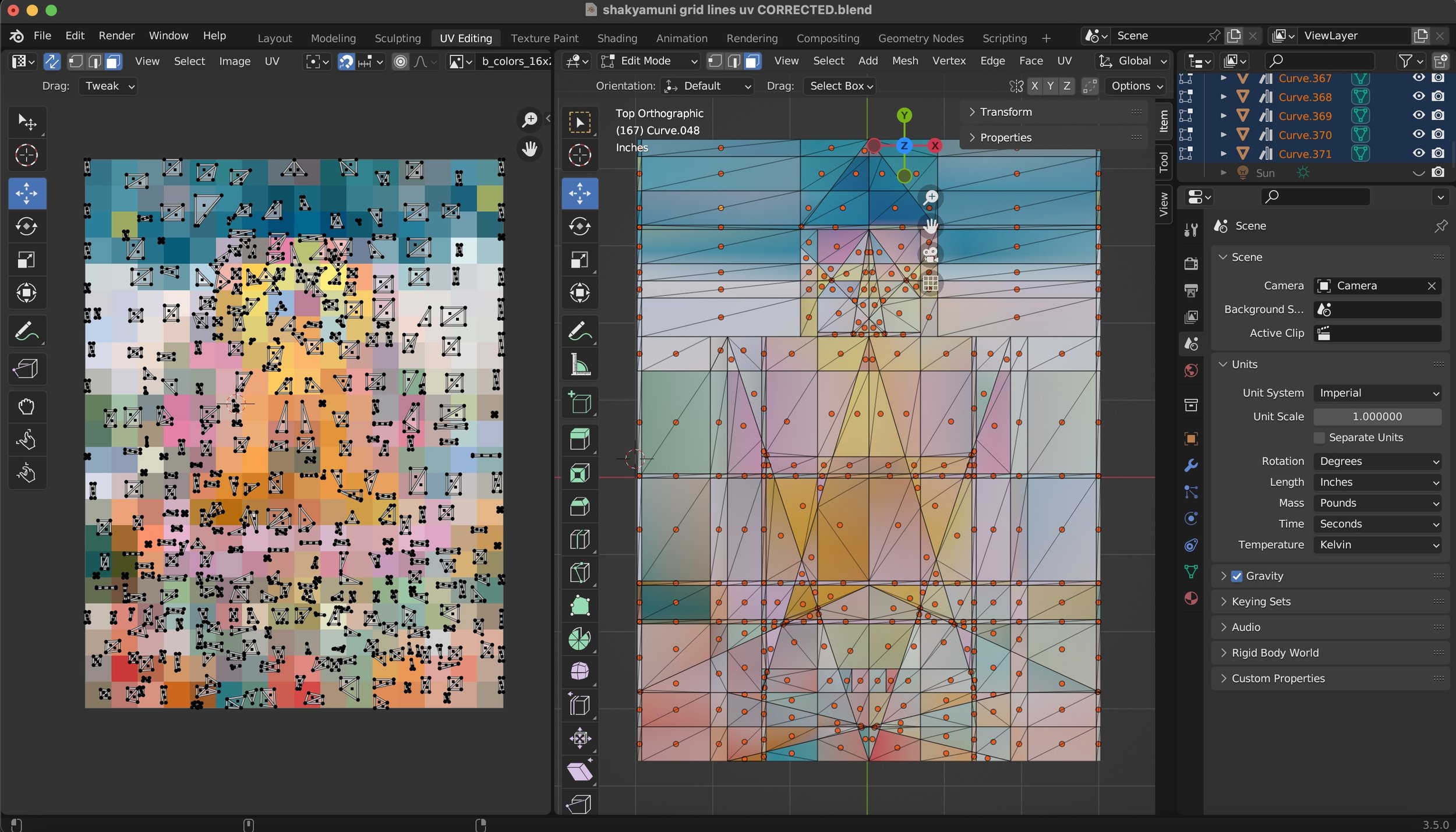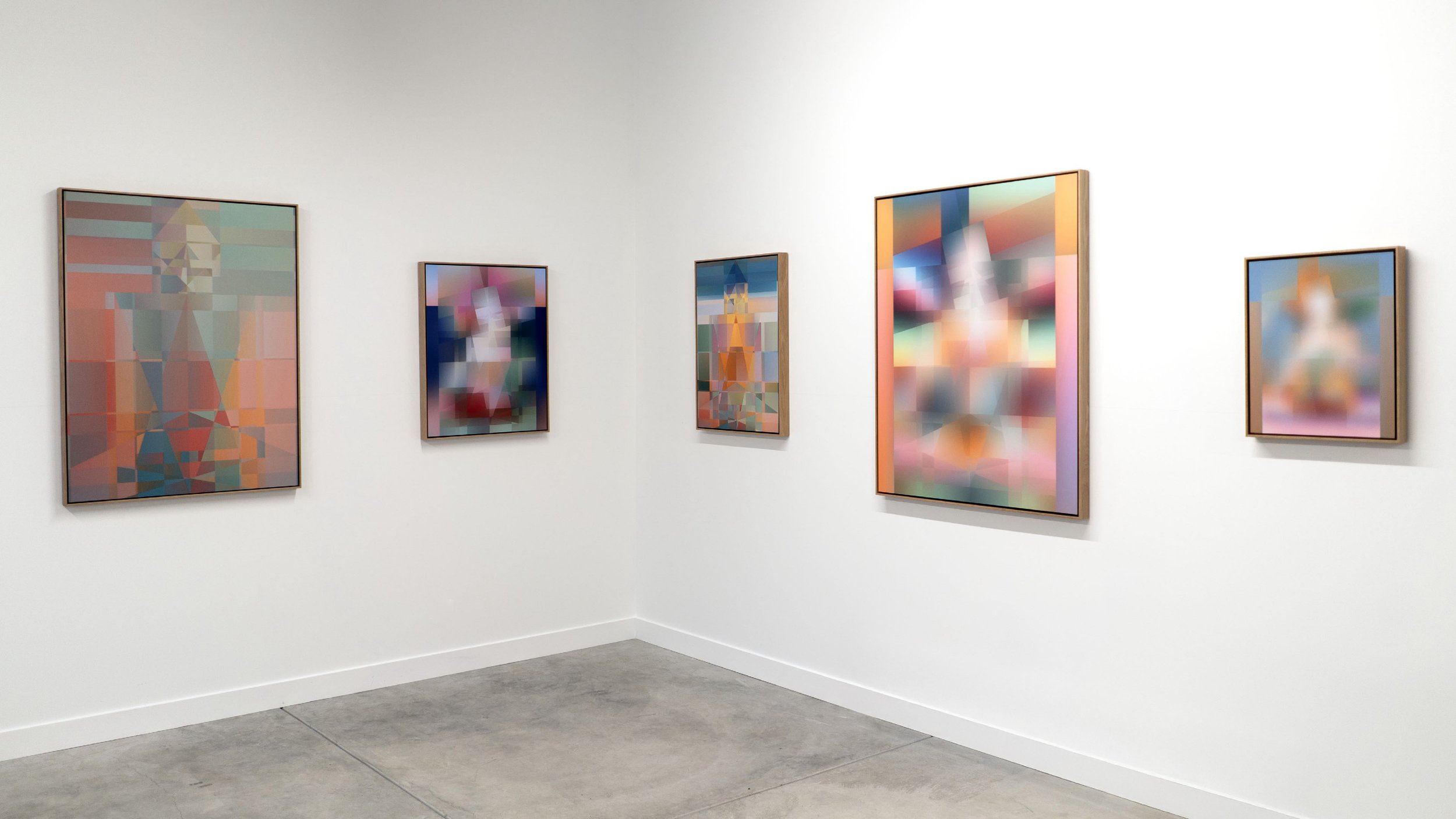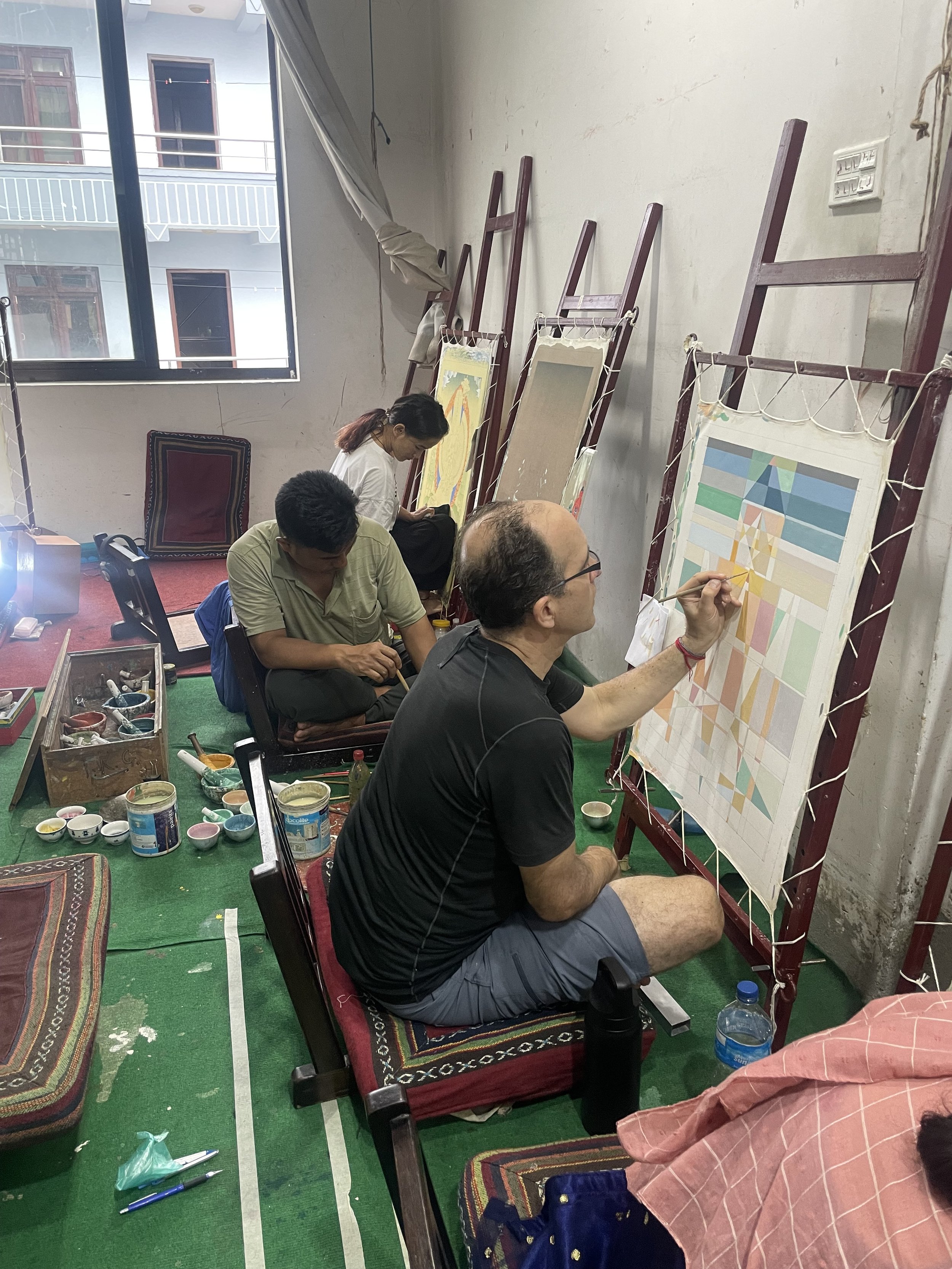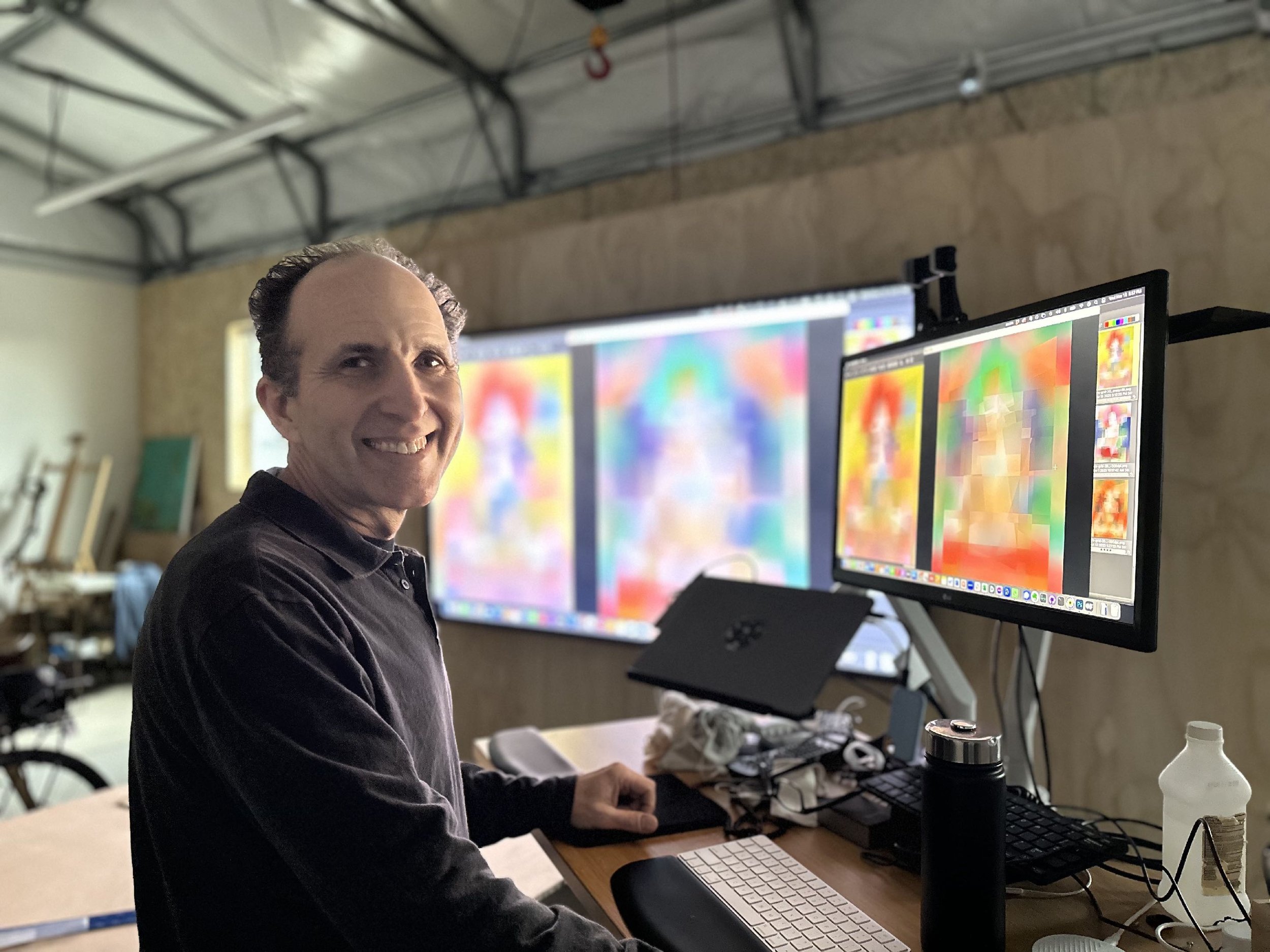Hidden Geometries (2023→)
The One Gone Beyond, 2023
Digital image, custom software
Protector of the World, 2024
38” x 48”, custom software, UV coated archival digital print on Dibond
The One Gone Beyond, 2024
18” x 24”, mineral pigments and hide glue on canvas
The One Gone Beyond (Ka), 2024
30” x 38” , Custom software, computer, digital display
Hidden Geometries is a series of digital and painted works inspired by the precise geometry that underlies the thousand-year-old tradition of Tibetan Buddhist thangka painting. When I began studying thangka painting in 2002 with Tsherin Sherpa in San Francisco, one of the first insights he shared was the unique geometric grid that forms each image’s foundation, guiding the artist's hand with purpose and precision.
Like the invisible structures that underlies reality, these grids have ensured the consistent representation of Buddhist figures and deities across centuries and cultures as the tradition evolved from India to Nepal and Tibet. The grids’ “sacred geometry” captivated me and became the inspiration for a series of abstract artworks exploring the unseen structure behind Vajrayana Buddhism's devotional art.
In 2023, I began reimagining these “hidden geometries” in works that delve into the inner experiences of meditators. These pieces seek to capture the vivid—yet imperfect—visualizations meditators form when engaging with Buddhism’s richly detailed devotional imagery.
A contemporary thangka painting of Shakyamuni Buddha
The grid underlying Shakyamuni Buddha
Composing the grids
I began by overlaying the traditional grids atop deity line drawings, making decisions as to how the grids could become compelling abstract compositions on their own. I started with Shakyamuni Buddha (the historical Buddha) whose grid is entirely symmetrical, expanding and aligning his grid into a rectangular composition.
Developing the Shakyamuni Buddha grid geometry into an abstract line composition
Adapting White Tara’s grid geometry to an abstract line composition
Drawing on Clay
Soon, I wanted to step away from the computer to work with more natural materials, and I began to draw the grids with India ink on clay boards.
The One Gone Beyond, 2023
16”x20”, ink and pencil on clay panel
Protector of the World, 2024
16”x20”, ink and pencil on clay panel
Perceptual Color
As I expanded from line to color, I wanted to convey the meditator’s inner experience of concentrating on a deity made entirely of light.
According to traditional instructions for meditating on a Buddhist deity, we are typically told to visualize the figure with as much detail as possible. However, my meditation teacher shared with me early on that it is normal for one to conjure a more diffuse image, and that this is perfectly acceptable as long as you incorporate the essential qualities of the deity into your practice, such as nonviolence, compassion, and wisdom.
In the still images for this series, much like those of twentieth-century European futurists, I tried to convey a dynamic process within a static image. That is, the dynamic process of shifting forms as one imperfectly tries to render a precise deity through one’s fuzzy awareness.
The images are also meant to convey the dynamic way in which deities appear from the void of “emptiness” (unlimited interdependent possibility), take specific form, and then dissolve back into that void.
The One Gone Beyond, 2023
24” x 32”, custom software, UV coated archival digital print on Dibond
To convey the fluidity and fuzziness of a meditator's focus, I wrote custom software that samples a low-resolution image of a thangka through the grid geometry. For the first image of Shakyamuni Buddha, I manually constructed the mapping of geometry to the colored regions of this low-resolution texture.
The ongoing series of digital prints for Shakyamuni Buddha explore variations sampled from the infinite possibly of mappings through the same low-resolution texture.
The One Gone Beyond (Nondual), 2024
36” x 48”, custom software, UV coated archival digital print on Dibond
The One Gone Beyond (Pure Lands), 2024
Work-in-progress
The One Gone Beyond (Channels), 2024
Work-in-progress
Algorithms for Hidden Geometries
To continue the series, I wrote a custom program that transformed my hand-crafted sampling process into a tunable algorithm, enabling me to create and import grids for other deities.
The software, written in C++ with the OpenFrameworks library, allows me to adjust the size and offset of polygon samples. Within the constraints of a given rule-set, there are infinite variations, so the program enables me to color each polygon according to any of the valid configurations for the rule-set.
The process of creating a satisfying image ends up feels like painting: carefully choosing the colors, tones, and gradations of each polygon to convey illusions of intersection, overlap, and emergence.
These images are reminiscent of the early 20th-century spiritual art that inspired me as a young person, including the works of Paul Klee, Wassily Kandinsky, and Lyonel Feininger.
Protector of the World, 2024
38” x 48”, custom software, UV coated archival digital print on Dibond
Mother of the World, 2024
25” x 32”, custom software, UV coated archival digital print on Dibond
Protector of the World (Primordial Awareness), 2024
17” x 21”, custom software, UV coated archival digital print on Dibond
Inducing a Meditative Experience
Framed, wall-mounted screens running a version of my custom software create long and infinite loops through the “state space” of the hidden geometries. The first, completed in late 2024, loops through variations that arise repeatedly from a single-colored void, complicate, and then dissolving back into that void.
The One Gone Beyond (Ka), 2024
30” x 38” , Custom software, computer, digital display (private collection)
Continuing the Thangka Painting Tradition
When I studied with Tsherin Sherpa, he explained that thangkas were traditionally painted using finely ground mineral pigments and bovine glues. I asked him whether I could obtain these materials to paint with myself, but he told me that he “only had enough materials for one lifetime”—those his father had brought with him when he escaped from Tibet and later shared with his son.
I couldn’t stop thinking about these materials and the idea of continuing the thousand-year-old tradition of thangka painting, blending modern imagery with traditional materials. Eventually, through a Japanese American painter I know who works with similar materials, I learned that you can obtain similar ground minerals from a supplier in Japan.
Then, through a remarkable series of chance encounters, I found myself invited in 2024 to Enlightenment Studio in Nepal, where I learned the traditional thangka painting techniques of canvas preparation, geometry, paint mixing, color, and shading directly from masters of each discipline. There, I completed my first painting using these traditional materials.
Scott Snibbe learning traditional mineral painting techniques at Enlightenment Studio, Nepal, 2024
The One Gone Beyond, 2024
18” x 24”, mineral pigments, hide glue on canvas
Traditional mineral pigments used in thangka painting including azurite, malachite, cinnabar, marble, hematite, and orpiment
Scott Snibbe laying out a painting at his studio in Berkeley, California using traditional Tibetan Buddhist thangka materials and techniques, 2024
The One Gone Beyond (Nondual), 2024
18” x 24”, mineral pigments, hide glue on canvas
(Prior to removing canvas from stretcher)
Scott Snibbe creating Hidden Geometries of White Tara in his Berkeley, California Studio, December, 2023





